Intro to Urban Beekeeping 2
Today I took a class at the Garden for the Environment called Introduction to Urban Beekeeping. This class is part of a series, and for those of you who are in San Francisco and are interested, I recommend checking out the remaining classes. It was taught by Paul Koski of the San Francisco Beekeeper’s Association, a knowledgeable and engaging teacher. I’ve been around bees and hives, but wanted to take this series to see if I felt comfortable starting a hive in my backyard.
We first learned about bee biology, the workers, the drones, and the queen. The workers are female and the drones are male, and the drones don’t do much but hang around and wait until they can mate with the queen, a pretty important job in the life of the colony. Once they’ve reached the end of their usefulness, they’re banished from the colony. If the egg is fertilized, it becomes a worker, if not, it becomes a drone. Drones and workers only live about 6-8 weeks. The queen can live up to 3-4 years.
Workers control the colony, build wax, protect and raise the young, and keep the hive together. After they emerge from their cell, they clean the cell for the queen to lay new eggs, then later turn into nurse bees, feeding the young. The queen dines on royal jelly, which determines her queen-ness (certain characteristics evolve as a result of her diet). The larva, pupa and eggs are called the brood.
The bees themselves are called the “colony,” and the “hive” usually (but not in some contexts) refers to the physical structure that they live in.
A colony can grow from 10,000 bees to 50 or 60,000 in early summer. When a hive grows too big, the queen pheremone which keeps the colony happy becomes too dispersed and they produce new queens, and some swarm with the old queen in tow to look for a new home not too far away. There can be only one queen.
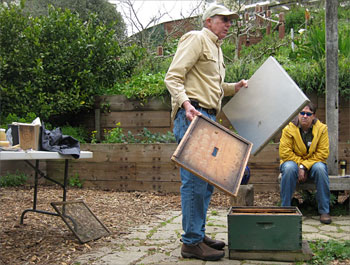
In this photo, Paul is demonstrating how you need to have two lids because the bees tend to attach the initial lid to the top of the hive
The type of hive we looked at and the most common type used here today is called a Langstroth hive, named for their inventor, Rev. Lorenzo Langstroth. Langstroth found that bees needed a certain amount of space to move around the hive in, and patented his hive in 1852. Prior to that, bees were kept in skeps, which are like upside-down baskets. With skeps, collecting the honey often resulted in the destruction of the colony.
The Langstroth hive is made up of the boxes, either hive bodies or honey supers, which can have a queen excluder that she can’t fit through so she can’t lay eggs. Each hive body or super has 8-10 frames.
We looked at some old frames with older queen cells.
In this one, the queen must’ve died inside, because it’s intact:
But in this one, the queen has flown the coop:
Then I found this picture that shows the queen larvae developing, surrounded by royal jelly:
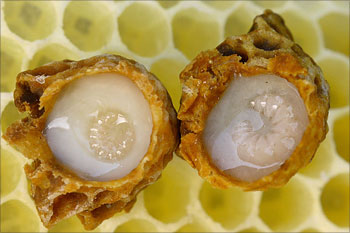
Photo by Waugsberg
Bees also exist in natural hives. Those of us who grew up in Manhattan don’t automatically get that.
After learning about the hive structure, we talked a little about locating a hive, tools and protective gear, and getting stung. Paul recommended getting an epi-pen in case of anaphalaxis. I’ll never forget the time I went on a group camping trip to Point Reyes and a good friend went into anaphalactic shock after being stung. It was scary, and she made it, but people do die from bee stings if they’re sensitive, so better to be prepared.
That was the extent of my detailed notes, but we learned much more, and went to look at a functional hive. It’s much better to check the bees on a sunny warm day, when they have a lot to do and lifting the lid on the hive won’t cause a change in temperature inside. Today was cold and wet, but we were able to take a quick look.
This hive at the GFE is pretty full, and is ready to be split soon. I hope I get a chance to check out that process.
Here’s a recent news story about keeping bees in San Francisco:
Am I ready to keep a hive in my backyard? I’m not sure. I’m thinking about their flight path and my neighbors, and Dave, who isn’t sure about it. I will learn more before I make that decision. It will be good if I can see what dividing the overcrowded hive to manage a swarm looks like, before it’s all up to me. I also want to find out more about how bees communicate with each other, and the concept of a superorganism.
Do you have a favorite beekeeping resource? Share it in the comments below. If you are a seasoned beekeeper, tell us if there’s anything you wished that you were told when you were first starting out, and if you have anything to add about bee biology or behavior, share that too. Bees are fascinating insects, I can’t wait to learn more about them. I hope to take the rest of the series and report back.
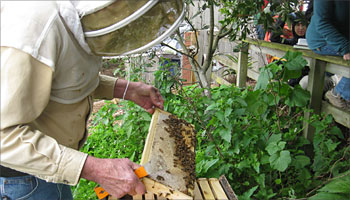
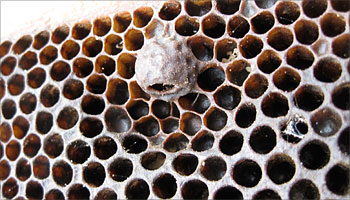
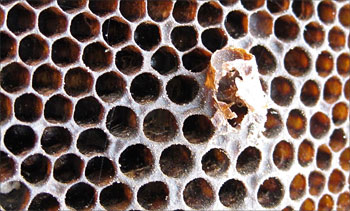
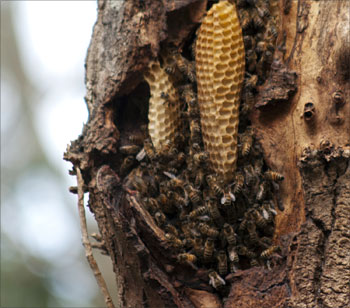

i love the post mom, but you should’ve included at least a small blurb about how important bees are to the agricultural world, and the food chain in general. but great post! i want bees now
So true! I’ll make sure to emphasize that in one of the next beekeeping posts. I really want to see Queen of the Sun, directed by Taggart Siegel, director of The Real Dirt on Farmer John. Tonight’s the last night it’s screening in SF.